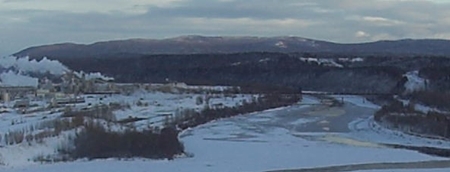City Serious About Melting A Channel In Jam.
By 250 News

Photo shows open water on the Fraser as a result of heated effluent from the mills (photo opinion250 staff)
Prince George, B.C. - City Manager Derek Bates says the plan to use hot water to try and melt a channel through the ice jam on the Nechako, is being seriously contemplated.
“The plan would see pipes at three spots along the river, one at the confluence, one about half the way to the Cameron Street Bridge, and the third at the Cameron Street Bridge.”
Bates says Canfor is on side with this idea, and is prepared to supply “low grade steam” to make it work. According to the City Manager, the water would be 20 degrees Celsius, and pumped into the River at a rate of 5000 gallons per minute “The warm water would be injected just below the surface and would have contact with the ice”.
Bates says the idea came from two sources. First, the Fraser River had not frozen over in the channel where the warm effluent from the mills is discharged. Secondly, the pump station west of the Cameron street bridge had been pumping ground water back into the river, and ice has not formed in that area. The groundwater is about 4 degrees warmer than the river water.
“It is safe, it is environmentally friendly as we will be using clean water” says Bates, but still, there needs to be approval from the Provincial Ministry of the Environment and the Federal Department of Fisheries.
The paperwork asking the Provincial Emergency Program to get these approvals is being hammered out now, as is the request for a technical assessment as was outlined to Prince George City Council last night. The documents will be sent to PEP tomorrow.
“I expect they (PEP) will request that we continue with the thermal modelling so we have a better picture of the impacts before they will agree that this is worthwhile “ says Bates, who adds the engineers say this idea is safe and “do-able”.
If the appropriate agencies give the go ahead, the costs involved to set up the pipes is very expensive. “It will be in the millions” says Bates, nearly 6 km of pipe will be needed, and it would be preferable to have the pipe in a trench to insulate against heat loss.
Previous Story - Next Story
Return to Home










